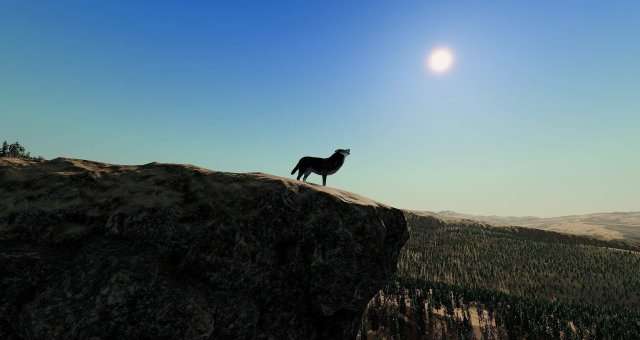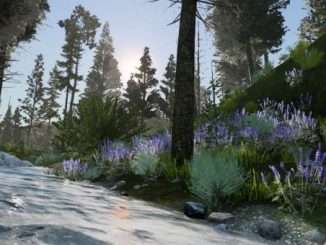
In Wolfquest Anniversary Edition, there is a variety of prey types to hunt. Knowing the behaviors of your quarry will make you a better and efficent hunter. This guide explores the behaviors of each prey animal and gives tips and tricks at every stage of the hunt, from the moment you first put on scent vision until the moment your prey gives its last breathe of life.
Introduction
All credit goes to mbiggiani!
Welcome to the guide! This guide covers every animal in depth, and discusses the tips and tricks necessary for a successful hunt. Every prey animal is different, so knowing their behaviors beforehand will lead to an easier and more efficient hunt.
Locating Prey
While prey animals are common across the map, it will take some effort to find them! Press V to activate your scent vision.
Scent Vision allows the player to smell other animals from great distances. Often, you will smell your prey long before you see it.
When in scent vision, the player will be able to see orbs of scent left behind by their prey. These scent orbs are color coated. In this guide we will focus only on the colors of the prey animals.
- Light Yellow – Snowshoe hare.
- Dark Blue – Mule Deer.
- Light Pink – Family Elk Herd.
- Dark Pink – Bull Elk Herd.
- Light Blue – Moose.
After awhile of following the scent orbs, you may come across the footprints of the animal you are looking for. These footprints tell a lot of information about the animals you are tracking. The footprints are color coded in the same way as the scent orbs. In addition, the game tells you the time that the footprints were made. Finally, the direction of the footprints indicates which way the animals went. After following these footprints, you will locate what you wish to hunt.
Snowshoe Hare
Where to look?
Snowshoe hare can be located all over the map, and spawn close to the player.
Behavior
Snowshoe hare often stand still before exploding away into a burst of speed.
The Hunt
Snowshoe hare should be an easy prey item, even for a new player. While they can be small and nimble, they are one hit and not too challenging to hunt. They provide only a little bit of food, so they aren’t worth it once a player has become more experienced at hunting.
Mule Deer
Where to look?
Mule Deer can spawn all over the map, but seem to be most common in large open clearings, where they have plenty of room to run and can locate predators easier.
Behavior
There are three different types of mule deer on the Amethyst Mountain map: Bucks, Does, and Yearlings. Bucks are solitary, while Does can either be solitary or in groups of 2 to 3. Yearlings spawn with a doe which is their mother, who will viciously defend it.
Unlike elk, mule deer herds are very disorganized and spread out. Therefore, if you happen to spook one mule deer and it happens to get away, it shouldn’t be a problem to just continue the hunt and focus on another mule deer. If one mule deer scatters, the rest usually won’t mind since they are so spread out.
Mule deer are the fastest of the ungulates in game, and perform a gait known as stotting. They also spook at a relatively farther distance than other prey items.
The Hunt
If you are hunting a yearling mule deer, be careful. Yearlings have less health than adults, but are guarded by their mother. Once you have bitten the yearling, you’ll want to make sure you avoid the flying hooves of the mother. Yearling mule deer stick very close to their mother.
Left click to target the camera on the Yearling and then move in circles to try and confuse the mother and get around to the baby. Once you have killed the baby, the mother will run off.
For adult mule deer, aim for the sides rather than the legs. It provides a better grip and allows you to hold on for much longer. Once the deer slows down to face you, aim for the head and neck, as those regions immobilize the animal while doing the most damage.
Overall, mule deer of all ages are suitable for a lone wolf. Having a mate only seals the deal for your quarry.
Elk
Where to look?
There are 18 herds of elk on the Amethyst map, named after foliage that can be found in the region. Elk are migratory animals, and move a lot depending on the time of year. In early fall, they are most common in the highlands in the northwest of the map, but by late fall they have migrate southeast towards the lowlands. If you are having trouble finding elk, you may just be looking in the wrong part of the map.
Behaviors
There are two types of elk herds in Wolfquest: Family herds and Bull Herds. Family herds have four types of elk: A bull, cows, spikes, and yearlings. Bull herds compose purely of mature bulls and consist of 3-5 individuals.
During the night, elk herds lay down to sleep for the night. Therefore, this is the best time for a player to hunt them. Attacking at night allows the player to get much closer before the elk have time to react and flee.
Unlike mule deer, elk herds may sometimes choose to stand their ground. In general, smaller herds are harder to spook than larger ones. This may seem counterintuitive at first, but a closer look at their behavior reveals why. Elk are selfish animals, and only care about themselves, and for cows, their yearling offspring. Elk are more vulnerable when they run than if they stand their ground. Therefore, an elk will only flee if it feels like it has a very small chance of being singled out by a predator. Since larger herds have more targets for a predator to attack, larger herds are more prone to flee than a smaller herd who has fewer members and where the chance of being killed is greater. Therefore, a player should try to attack a larger herd.
The Hunt
Elk are bulky animals, and traveling in a herd only compounds the problem. A player should try to drive the elk herd into a forest, where rocks and trees will slow the animals down and expose weaker individuals.
In addition, the player should not try to single out an individual elk right away, but wait for an animal to lag behind and become an easy meal. Often, young calves will split away from the herd on their own out of fear of being hunted.
For hunting yearling calves, a lone wolf is suitable. However, the player should pay attention to where the mother is at all times. First, single out the calf either by waiting for it to split from the herd or bite it to slow it down. Let go once the mother rushes in. At this point, the player should wait for the herd to get some distance away before continuing the hunt. If the player rushes in too soon, the mother and yearling may try to break away and return to the herd. Keep yourself between the herd and your prey until the herd has stopped running and begins to graze some distance away. From here it is the same as hunting a yearling mule deer.
For adult elk and spikes, a pair is recommended. Bite the elk on its sides to get a better grip and to slow it down. Continue biting on the sides until the animal stops and begins to collapse to its knees and dies.
Moose
Where to find?
Moose can be found throughout the map.
Behavior
There are three types of moose in the Amethyst Mountain region: Bulls, Cows, and Yearling calves. Adult moose are solitary animals. Moose are only seen together when it is a mother with her calf.
Moose almost always stand their ground during a hunt. Therefore you may have to bite them a few times before they start to run.
The Hunt
When hunting calves, there are several tips to consider. Baby moose often wander much further from their mothers than yearlings of other species, so it is often best to just wait for it to wander too far from its mother to initiate the hunt. In addition, adult moose are very bulky, so hunting in dense woodland is advised, especially when hunting baby moose.
Once you have bitten the baby moose, the mother will come rushing over to defend its baby. Like other yearlings, circle the pair to confuse them. However, with baby moose, they will split from their mother much more easily. Therefore, don’t initially bite them, but herd the calf away from its mother until you have gained a lot of distance and then bite it to get a lot of damage in.
For cow moose, aim for the sides. A pair is recommended as these animals can do a lot of damage.
Bull moose are extremely aggressive and will even charge wolves if you get too close. While an experienced wolf in a pair could possibly take one down, it is best to save the bull moose hunt for a multiplayer setting.





Be the first to comment